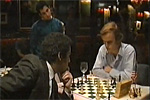


Kasparov's stint of playing impossibly strong clock simultaneous exhibitions began in 1985, when he took on the Bundesliga team of Hamburg, Germany. This was the professional squad of eight players, led by GM Murray Chandler on board one. Kasparov knew nothing about most of the other opponents, was tired and got into time trouble. He lost that simul by 3½-4½ – the first and only time this has ever happened to him. He swore to return for revenge.
And return he did, in January 1987. A couple of days before the simul Frederic Friedel and Matthias Wüllenweber handed him the very first copy of a program they had named "ChessBase" – no number behind it, but the serial number of the 3.5" floppy disk was 00001. It contained all available games of Kasparov's opponents, this time from a Hamburg team that was nominally stronger than the one to which he had lost just over a year earlier.

The ChessBase program on Atari ST back in 1987
Kasparov spent two days preparing for the opponents, on an Atari ST – a computer with 512 kilobytes of memory and no hard drive, but with a sharp black and white monitor. With the home prep the clock simul went differently: Kasparov crushed his opponents 7:1.

In late 1988 Kasparov was working on an Atari ST with a 20 MB hard disk
(!)
This experience was so exhilirating that Garry started to do it on a regular basis – and take on stronger and stronger opposition: the Swiss national team, the French (twice), the US junior team, the German junior team, the German Olympiad squad and finally the Argentenians and the Israelis. It was always preceeded by careful preparation, initially on the Atari, then on PCs when ChessBase migrated to this generation of computers.

Kasparov proudly presents the latest ChessBase running on a PC – in
1988
In early 1988 Kasparov took on the American juniors. This was a viciously strong squad of six young players, and the general consensus was that in a clock simul he did not stand a chance. The match took place in the famous Russian Tea Room in New York. The rest of the tale is told in three parts by the following film that was produced after the event and uploaded to YouTube by Larry Millington from Warrington, England. Take the time to absorb the atmosphere, listen to the players and experience how a clock simul is played. The games are given at the bottom of the page.
In one section (starting from around seven minutes into the video) Danny Edelman says: "Tonight, it doesn't matter if I win, it doesn't matter if I draw, it doesn't matter if I lose. I hope to engage in one of the brilliant games. If I lose it is because of a beautiful attack, and wonderful that I am part of something; and if I draw then equally so; and if I win, well, that will be excellent as well." Watch what happens in the next segment.
There is a cute section starting from 8 min 30 sec: Sofia Rohde, wife of the grandmaster, had been intructed to have Toblerone available for Kasparov, who used it to get his blood sugar up after a number of hours of play. Sophia got chocolate for the other players as well, but warns them repeatedly not to touch the Toblerone. She is on Facebook in case you want to know more about the staging of such events.
The commentator at the demo boards is Sofia's husband GM Michael Rohde, who is in the Manhattan Chess Club across the road and getting the moves on scoresheets carried by a running courier – cutting edge technology at the time.
The most poignant scene in this video comes at 3 min 20 sec, where Kasparov repeats moves, expecting his opponent to deviate.
Edelman,Daniel (2360) - Kasparov,Garry (2750) [B33]
New York sim New York, 1988
1.e4 c5 2.Nf3 e6 3.d4 cxd4 4.Nxd4 Nf6 5.Nc3 Nc6 6.Ndb5 d6 7.Bf4 e5 8.Bg5
a6 9.Na3 b5 10.Nd5 Qa5+ 11.Bd2 Qd8 12.Bg5 Qa5+ 13.Bd2 Qd8

This is a strategy of simultaneous masters, and Garry used a number of times in his own exhibitions. White can repeat and take the draw, or play on with a deviation that leads to an unclear position without a clear advantage. Watch Edelman's face when Kasparov plays 13...Qd8. After some thought he takes the draw: 14.Bg5 ½-½. Kasparov is deeply upset: "You have white, you have to play. That is my opinion, sorry. When I was young I would never have missed a chance to play the World Champion." He offers Edelman the chance to continue, but after consultation Sophia signals that the draw is taken.
Starting from 8 minutes you see Patrick Wolff with his at the time trademark hat putting the pressure on Kasparov. Watch him glare at his opponent and then play 22.Qh6-d2, knowing that he is winning.
The final section show Patrick, who later worked with Vishy Anand, defeat Kasparov. It is quite moving to hear him explain what that feels like. Meanwhile Rachels, who was doing very well in the middlegame, gets blitzed by Kasparov. The film very nicely captures the end of the game, starting from around 3 min 15 sec. Watch the faces and the demeanor of the two players. Beautiful stuff. At around 6 min 30 sec, Kasparov blunders into a draw against Alex Fischbein – watch Garry flash out the winning move, 56...d2!, immediately after the draw is agreed.
In the end Kasparov wins the simul 4-2. Click here to replay and download these historical games.